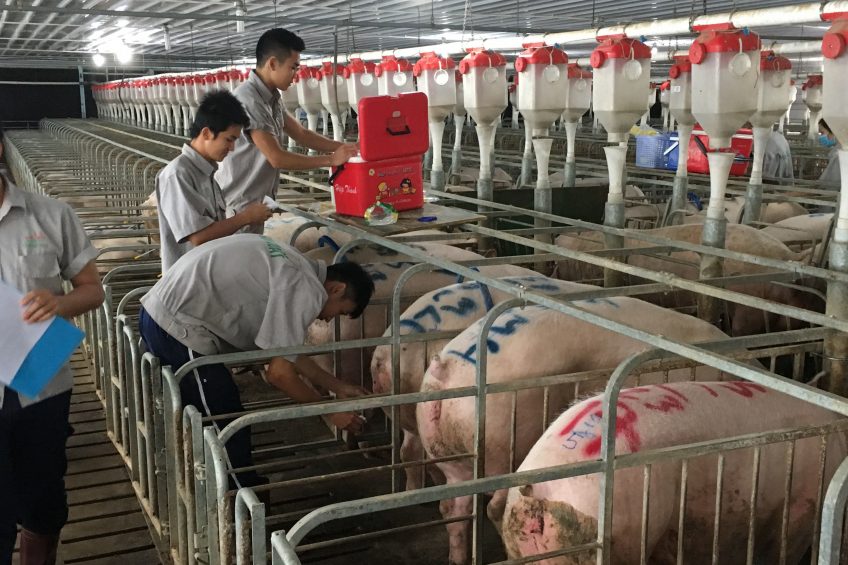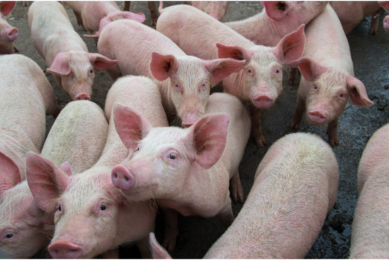GreenFeed growing sustainably in Vietnam

When an integrator calls itself ‘GreenFeed’, surely there must be something sustainable and innovative about its pig production chain. Indeed, this Vietnamese company invests in the future, with sustainable recycling techniques, and a lot of attention paid to attracting and keeping its employees – and an online meat delivery service.
GreenFeed is one of Vietnam’s largest integrators in the field of swine production. It started small 15 years ago as a soybean crusher, working with multinational agricultural commodity supplier Bunge. Subsequently, GreenFeed moved into feed milling. Currently, the company produces more than 1,000,000 tonnes of feed per year and has six mills in Vietnam, one in Cambodia, one in Myanmar plus a mobile mill-and-mix plant in Laos.
Selling feed is a competitive business
Selling feed to individual pig farms is a very competitive business. Having an integrated operation means a guaranteed market for feed at cost plus a saleable product, i.e. slaughter pigs. That is why many feed companies these days establish their own pig units. GreenFeed now owns 20,000 sows, with the aim of hitting 100,000 sows by 2023.
Breeding stock: A PIC dealer
Randolph Zoerb is GreenFeed’s deputy general director of farm training. He says, “GreenFeed has had links with PIC for many years and in fact has had the PIC franchise for Vietnam since 2010. We sell PIC stock both to our own farmers and to third-party clients as well.”
He continues, “GreenFeed has two artificial insemination studs each of 300 boars. These studs contain both sire and dam lines with some boars being imported from the USA whilst others have been born in Vietnam. The nucleus farms only import boars and some gilts from nucleus herds in the USA and Canada, in order to reduce genetic lag. It’s far cheaper to bring genetics into Vietnam in the form of semen and it’s possible to transport semen from Saskatchewan to Vietnam in 72 hours.
“The extenders used give semen a five-day life and so fresh, not frozen, semen can be used. GreenFeed has bred its own F1, the GF24, (derived from the Camborough 24), which is noted for her robustness, feed intake and survivability. We cross these with either the GF 399, 337 or 280 terminal sires.”
Challenges for GreenFeed in Vietnam
The challenge is keeping pigs alive, explains Mr Zoerb. He says, “We get 30-40 pigs born alive per litter, but we can only wean 28-30. Interestingly, the local small producers wean around 25 piglets per sow per year.” The ‘back yard guys’, as he calls them, are still between ten and 20 piglets per sow per year.
Major issues in Vietnam are feed intake and health, Mr Zoerb explains. He says, “We feed sows twice per day in gestation. Lactating sows get fed at the cooler times of the day to maximise feed intake. Regarding health, we have Foot-and-Mouth Disease (FMD), Classical Swine Fever (CSF), Porcine Reproductive and Respiratory Syndrome (PRRS), Porcine Epidemic Diarrhoea (PED) and respiratory diseases. Here it’s hot and humid, ideal conditions for diseases to incubate.”

Read more on pig production in Vietnam
He continues to say, “We are lacking in ‘hands-on’ large animal vets – and if we have a major problem, we have to bring in outside veterinary expertise. Also we have very few diagnostic labs, although these will come in time.”
He concludes, “We naturally have access to veterinary products: vaccines, antibiotics and etc. and the pharmaceutical companies help us by providing back up veterinary advice and support.”
Labour on the GreenFeed facilities
With regard to labour, Mr Zoerb says, “Not that long ago, labour was plentiful, as we could pay staff more than the rates other local farmers were offering. Industrialisation in the cities attracted labour away from rural areas plus on the large pig units staff live on-site, so they never get ‘away from the job’, even when not working. The social clock is ticking and staff can be difficult to retain. Hence we are looking to Cambodia and Myanmar for staff.”
Just like in Europe and Northern America, mechanisation is increasing to reduce the mundane aspects of looking after pigs. About 90% of feed is fed dry with bulk delivery, gradually replacing bagged feed.
Motivated staff on pig farms is vital
GreenFeed realises that having keen motivated staff is vital in order to maximise output and profitability. To this end the company has a well-developed training programme, with staff being taught husbandry skills in a ‘hands-on’ situation. Experts are brought in when required to teach more advanced procedures.

Also read this farm feature on Tan Uyen farm in Vietnam’s Binh Duong province.
Contrary to farm managers of the past, GreenFeed teaches its potential leaders people management techniques. The company pays considerable importance to team building and sports competitions are used to encourage employee bonding and team spirit.
The company also produces an attractive, colourful monthly publication, called GreenFeed News. It contains relevant information about company trends and developments. Furthermore it contains league tables of the various GreenFeed units, comparing units by output which encourages competitiveness between the various company farms.
GreenFeed and feeding regulations
Vietnamese consumers are now becoming increasingly concerned about how their food is produced. The Vietnamese government has banned antibiotic growth promoters and as a company GreenFeed does not use high levels of zinc oxide post-weaning. Bone meal is used as a feed ingredient but meat meal is not fed, neither is plasma, due to biosecurity risks.

Environmental concerns
Many large GreenFeed farms have covered lagoons. Biogas powered engines are powering generators, with the electricity powering fans, heat pads, lamps etc. Worms are used to convert manure into saleable fertiliser with the worms being used as a protein source.
Marketing the pig meat
To maximise profit, GreenFeed is selling its meat under its own brand label, called Wyn Pork. In Ho Chi Minh City, pork products are sold in convenience stores – quite a step forward from open air wet markets.
Large pictures of the different cuts are displayed inside the Wyn shops and customers can simply order by quoting a product number. The same cuts are also pictured in a glossy high quality brochure. The cuts can then be ordered online, after which they will be delivered by motorcycle.

Cutting out middlemen, GreenFeed is opening its own abattoir this summer in Ho Chi Minh City. It will be approved for exports and will initially operate on the basis of three shifts, each of 6 hours. If this venture proves successful, slaughter throughput will be increased.
Thanks to Olmix for making this article possible.











